IBPS RRB Clerk Mains Quantitative Quiz
Quantitative Aptitude can enhance your performance as a whole. All you need to do is clear your basics first and practice more and more. Quantitative Aptitude is a subject that helps you to boost your score and confidence. Every year IBPS comes with changes in the pattern of questions on Quantitative Aptitude which makes it difficult for students to decode in the examination hall. Giving mocks and Quizzes on a regular basis will help you to crack every change in the pattern. Adda 247 gives daily quizzes for practice as the IBPS RRB Clerk Mains is scheduled for 20 October. This is a quiz based according to the same pattern that was asked on IBPS RRB PO Mains. Here is the IBPS mains Quantitative Aptitude Quiz of 19th October 2019.
Directios (1-5): Study pie chart and table carefully to answer the questions that follow.
Pie chart shows percentage distribution of vehicles in four different cities
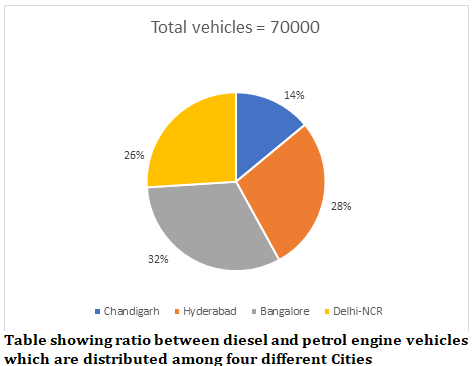

Q1. What is the difference between the number of diesel engine Vehicles in Hyderabad and the number of petrol engine Vehicles in Delhi-NCR ?
(a) 15900
(b) 2100
(c) 2800
(d) 3400
(e) 16100

Q2. Number of petrol engine vehicles in Bangalore is what per cent more than the number of diesel engine vehicles in Chandigarh ?
(a) 100%
(b) 200%
(c) 300%
(d) 125%
(e) 225%

Q3. If 25% of diesel engine vehicles in Bangalore are AC and remaining vehicles are non-AC, what is the number of diesel engine vehicles in Bangalore which are non-AC ?
(a) 7500
(b) 4500
(c) 9500
(d) 10500
(e) 3500

Q4. What is the difference between the total number of vehicles in Bangalore and the number of petrol engine vehicles in Hyderabad ?
(a) 9600
(b) 10600
(c) 11200
(d) 10200
(e) 9800

Q5. What is the average number of petrol engine vehicles in all cities together ?
(a) 8675
(b) 8925
(c) 8975
(d) 8625
(e) 8875
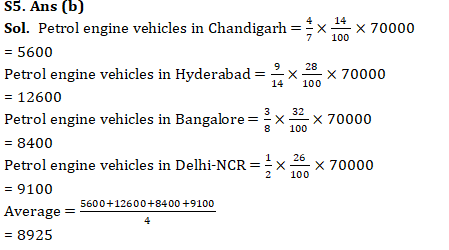
Q6. Pipe A can fill the tank in 4 hour, while pipe B can fill it in 6 hours working separately. Pipe C can empty the whole tank in 4 hours. Ram opened the pipe A and B simultaneously to fill the empty tank. He wanted to adjust his alarm so that he could open the pipe C when it was half-filled, but he mistakenly adjusted his alarm at the time when the tank would be 3/4th filled. What is the time difference between both the cases, to fill the tank fully :
(a) 48 min.
(b) 54 min.
(c) 30 min.
(d) 44 min.
(e) Can’t be determined
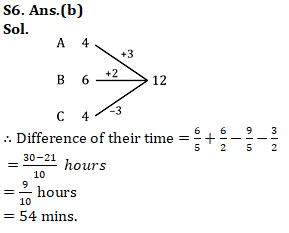
Q7. Tap A can fill the tank in 10 hours and B can fill it in 15 hours. Both are opened simultaneously. Sometimes later tap B was closed, then it took total 8 hours to fill the whole tank. After how many hours B was closed ?
(a) 2
(b) 3
(c) 4
(d) 5
(e) None of these

Q8. Anoop sells a book to Mayank at a profit of 20% and Mayank sells this book to Siddharth at a profit of 25%. Now Siddharth sells this book at a loss of 10% to Shishir. At what percentage loss should Shishir sell this book so that his SP becomes equal to Anoop’s CP?
(a) 36.68%
(b) 25.92%
(c) 48.66
(d) Cannot be determined
(e) None of these

Q9. The profit on an article when it is sold for Rs. 720 is half of the loss when the same article is sold for Rs. 420. find the cost price of the article.
(a) Rs. 620
(b) Rs. 700
(c) Rs. 520
(d) Rs. 840
(e) Cannot be determined

Q10. Out of his monthly income, Mr Raj spends 20% on house rent and 70% of the rest on household expenditure. If he saves Rs. 3600 per month, then his total income per month in Rs. is
(a) 10000
(b) 15000
(c) 10500
(d) 12000
(e) None of these
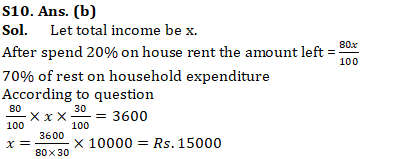
Directions (11-15): Calculate quantity I and Quantity II on the basis of the given information then compare them and answer the following questions-
Q11. Quantity I → Distance travelled by the bus to reach point B from point A if a car travels the same distance in 5 hrs and the speed of the bus is 120 km/hr which is 120% of the speed of the car.
Quantity II→ Distance travelled by a boat to reach point D from point C if the speed of the boat in still water is 15 km/hr and speed of current is 3 km/hr. It goes from point C to D downstream and return back from point D to C upstream in 25 hrs.

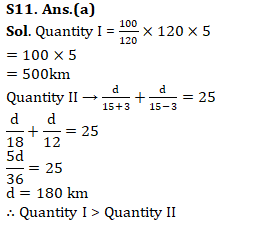
Q12. Quantity I → Value of a number which is 25% more of a number which is 75 less than 225.
Quantity II→ Value of a number which is 87% less than a number which is 25% more than 1200.

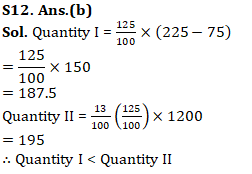
Q13. Quantity I — The time in which 17000 Rs. gives interest of 2211.0625Rs. at 5% per annum CI.
Quantity II— The time in which 22000 Rs. earns interest of 3630 Rs at 6% per annum SI.

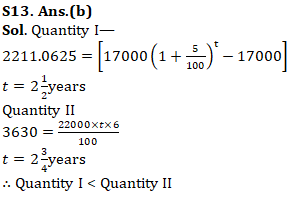
Q14. Quantity I — The percentage increase in Area of a circle, when the radius of the circle is increased by 100%.
Quantity II — The percentage increase in Area of a rectangle when length is increased by 150% and breadth of the rectangle is increased by 60%.

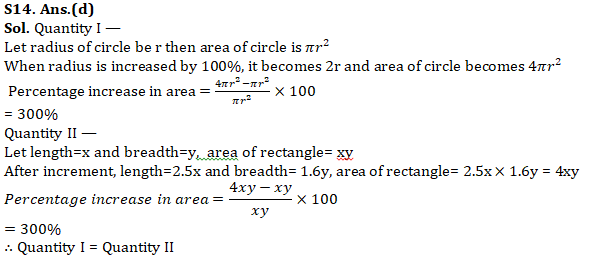
Q15. Quantity I — Time taken by Pallavi to complete the work, if Baby and Pallavi can do the same work in 7 days while ratio of efficiency of Pallavi and Baby is 7:4.
Quantity II — Time taken by Gaurav, Vivek and Babu all together to complete a work, if efficiency of Gaurav is half of Vivek and efficiency of Babu is half of the efficiency of Gaurav and Vivek together. The time taken by Babu alone to complete the work is 12 days.

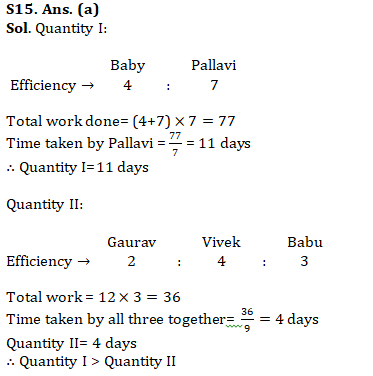
For 200+ most important arithmetic questions
- Quantitative Aptitude Study Notes for Bank Exams
- 100 MCQs Data Interpretation | Download Free PDF’s of DI
- Quantitative Aptitude Questions for all Competitive Exams
- LIC ADO Mains Result 2019
All the Best BA’ians for IBPS RRB Clerk Mains

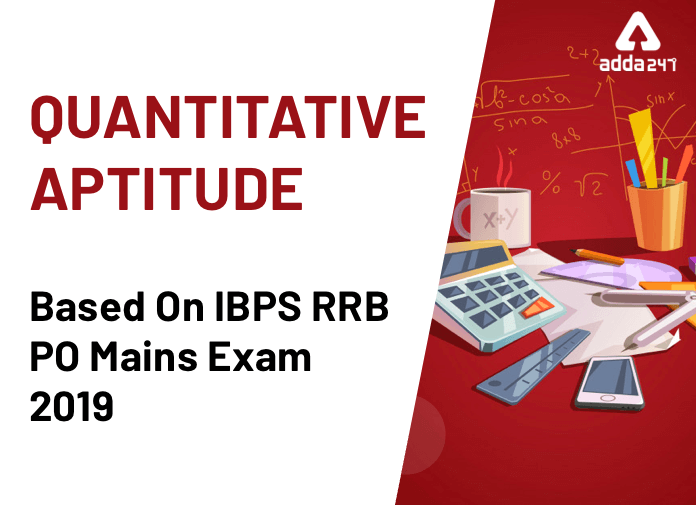
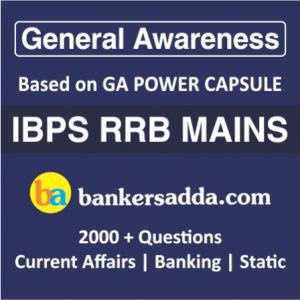


 GA Capsule for SBI Clerk Mains 2025, Dow...
GA Capsule for SBI Clerk Mains 2025, Dow...
 The Hindu Review October 2022: Download ...
The Hindu Review October 2022: Download ...
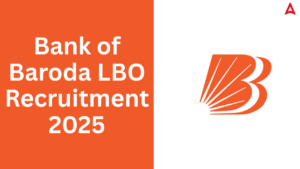 Bank of Baroda LBO Recruitment 2025 Noti...
Bank of Baroda LBO Recruitment 2025 Noti...


